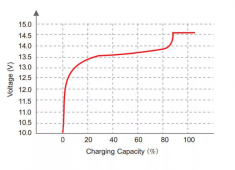I am upgrading to Lithium iron phosphate batteries in my travel trailer. I understand electricity, and solar pretty well, but I have noticed the videos on this topic of using vehicle Alternators to charge Lithium Iron Phosphate batteries seems to generate a bad response in his videos. He basically said it was too expensive for the special electronics to do it right. So before I knew the lithium iron phosphate batteries were the way I was going to go, I bought a GMC 3500 with dual lead acid batteries and dual alternators 220A primary with 170A secondary. I also had a high idle switch installed on my truck so I can run the RPMs at 1500 to generate more electricity faster specifically to charge the house batteries of the travel trailer when I am hunting off grid for weeks in Montana without having to carry an additional generator (although I have a Honda 2200, but it is a long way to bring gas with me). Anyway, I have noticed in these threads, people are using what I have found which is the Victron Orion TR converter to convert the energy from the standard vehicle to the lithium Iron Phosphate batteries. To complicate this further, I was going to put in the 24V system for all the many benefits of such.
I am not going to change out the alternators on the truck, or do anything like that, so anyone should be able to hook up to this trailer and have some level of charging to the lithium iron phosphate batteries even at 24VDC.
Of course, I like the benefit of getting the batteries charged while driving as well, and I hope this is just to supplement the low solar output I will have in the cold at Northern latitudes of Montana, Idaho, and WA state.
So my main point is this, before I spend $250 on a Victron 12V to 24V DC lithium charging converter to use my alternators to charge my house batteries, have I missed anything that makes this not technically work? Should I build a 12V system out of simplicity instead even though the benefits of 24 seem worth it to me.
Secondly, is it worth it assuming I have a wire large enough from the alternators to the 7 way connector? Will it charge my 4 Lion UT1300 batteries in a series parallel configuration to make 2 24VDC batteries in a reasonable amount of time at 24VDC, assuming I have a 40amp fuse after the alternators and a large enough wire from the alternators to the 7 way connector? I can carry the generator, and the gas, but it is just more stuff people can steal while I am away from the trailer while hunting.
Does this make sense, or am I basically wasting $250 I could spend somewhere else? Should I build it 12VDC, and should I separate the alternators entirely, and use a generator to charge the batteries? Thoughts?
Finally,
I am not going to change out the alternators on the truck, or do anything like that, so anyone should be able to hook up to this trailer and have some level of charging to the lithium iron phosphate batteries even at 24VDC.
Of course, I like the benefit of getting the batteries charged while driving as well, and I hope this is just to supplement the low solar output I will have in the cold at Northern latitudes of Montana, Idaho, and WA state.
So my main point is this, before I spend $250 on a Victron 12V to 24V DC lithium charging converter to use my alternators to charge my house batteries, have I missed anything that makes this not technically work? Should I build a 12V system out of simplicity instead even though the benefits of 24 seem worth it to me.
Secondly, is it worth it assuming I have a wire large enough from the alternators to the 7 way connector? Will it charge my 4 Lion UT1300 batteries in a series parallel configuration to make 2 24VDC batteries in a reasonable amount of time at 24VDC, assuming I have a 40amp fuse after the alternators and a large enough wire from the alternators to the 7 way connector? I can carry the generator, and the gas, but it is just more stuff people can steal while I am away from the trailer while hunting.
Does this make sense, or am I basically wasting $250 I could spend somewhere else? Should I build it 12VDC, and should I separate the alternators entirely, and use a generator to charge the batteries? Thoughts?
Finally,



